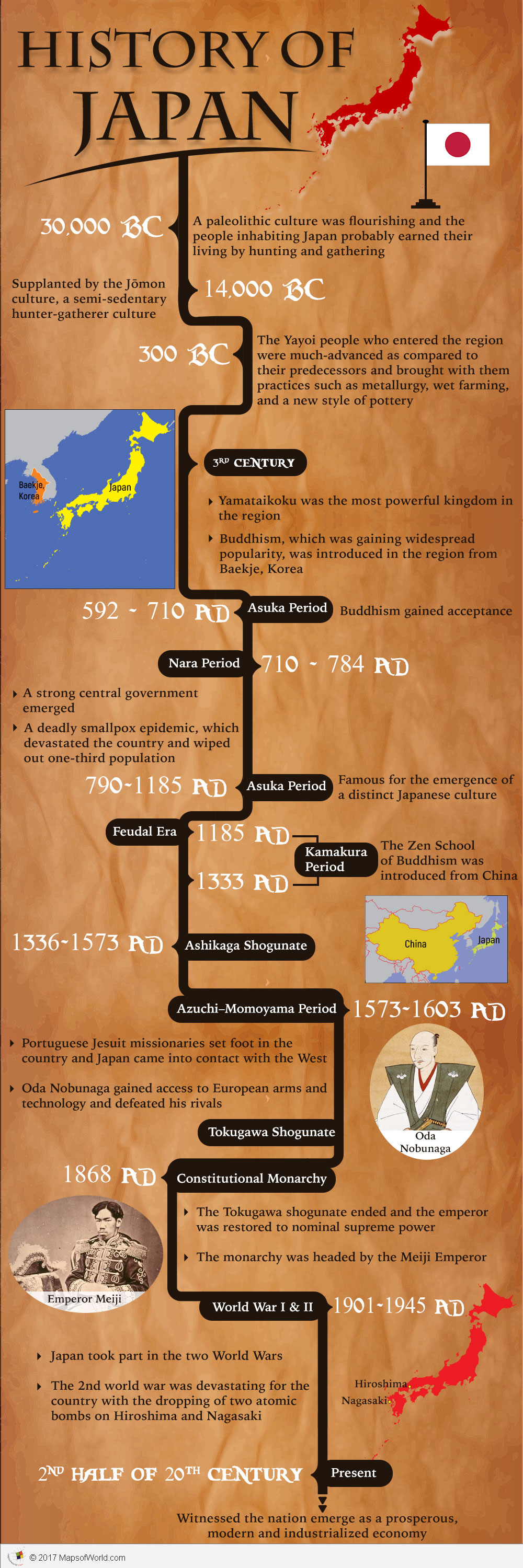

A graphical representation of the rich and ancient history of Japan
The history of Japan dates back to prehistoric times. Japan is a very old country and it is hard to determine when civilization began in the country. In this article, we will explore how old Japan is, interesting facts and more.
It’s difficult to pinpoint an exact age for the country of Japan. However, following key milestones can be considered to understand the age of Japan. These includes:
The earliest evidence of human habitation in Japan dates back to the Paleolithic Period (30,000 – 10,000 BC). These hunter-gatherers lived a nomadic lifestyle and used basic stone tools.
This period is named after the characteristic cord-marked pottery made by the Jomon people. They were a settled society who lived in pit houses and subsisted on hunting, fishing, and gathering.
This period saw the introduction of rice cultivation and metalworking from mainland Asia. The Yayoi people also built more permanent dwellings and developed a more complex social structure.
Powerful clans emerged during this period, building large burial mounds (kofun) for their leaders. This era also saw the introduction of Buddhism and the development of a writing system based on Chinese characters.
The Yamato court established itself as the dominant power in Japan during this period. They built the first permanent capital at Heijo-kyo (present-day Nara) and centralized control over the country. This period also witnessed the deadly smallpox epidemic that devastated the country and led to a massive loss of life.
The Heian period was marked by a flourishing of culture and the rise of a powerful aristocracy. Literature, poetry, and art forms like calligraphy and ink painting reached new heights. However, the power of the imperial court gradually declined towards the end of this period.
In this period, military leaders (shoguns) seized power from the emperor, establishing a feudal system in Japan. Samurai warriors became the dominant class, and Zen Buddhism gained popularity.
This period was marked by constant warfare between rival feudal lords (daimyo). It was also a time of cultural exchange with China, leading to the development of tea ceremony, ink painting styles, and Zen gardens.
Powerful warlords like Oda Nobunaga and Toyotomi Hideyoshi unified much of Japan during this period. They introduced social and economic reforms and paved the way for a more stable era.
The Tokugawa shogunate established a strict social hierarchy and a policy of isolation from the outside world. This period saw a flourishing of merchant culture, art forms like kabuki theater and ukiyo-e woodblock prints, and the development of a unique Japanese identity.
The overthrow of the Tokugawa shogunate ushered in a period of rapid modernization. Japan adopted Western technology and political systems, becoming a major world power in the early 20th century.
Related Links
The Republic of Madagascar is an island country located in the Indian Ocean, off the…
The Euro is the official currency of the European Union. It is, however, not incumbent…
There are many countries or regions that are partially recognized by the UN, have disputes…
The Alaska Statehood Act was signed into law by President Dwight D. Eisenhower in 1958,…
The name Persia may, however, only be used to refer to Iran in some contexts.…
Hawaii is an Island State in the US. It is one of the 50 states…